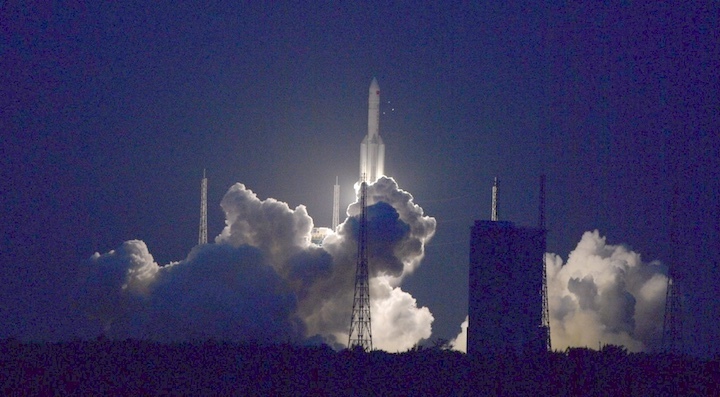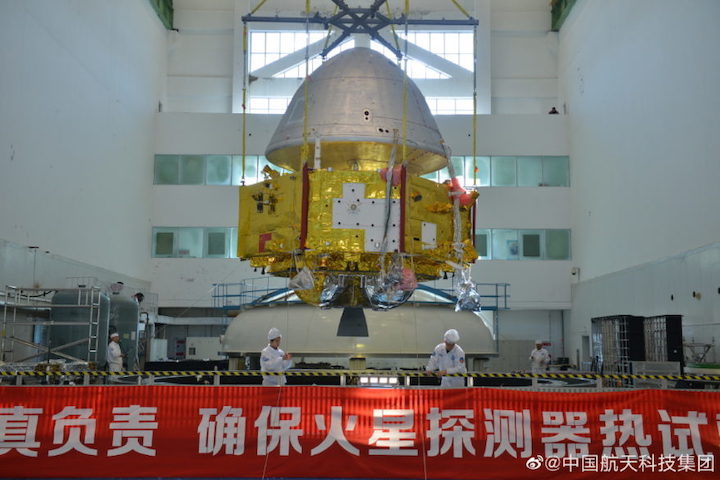15.10.2019

HELSINKI — China is set to attempt a return-to-flight of its Long March 5 rocket at the end of the year, with success required for the country to proceed with its major space ambitions.
Two cargo transport ships left port on the Yangtze river late Friday Eastern for the northern city of Tianjin. They are expected to collect components of a third Long March 5 heavy-lift launch vehicle, which has been grounded since a 2017 launch failure.
After expected arrival Oct. 15 and subsequent loading, Yuanwang-21 and 22 ships will deliver the rocket to the island province of Hainan. Launch preparations requiring about two months will then commence at the Wenchang Satellite Launch Center.
The launch expected late December will attempt to send the Shijian-20 experimental communications satellite into geosynchronous transfer orbit. The satellite is based on a new, large DFH-5 satellite platform which supports satellites from 6,500 to 9,000 kilograms.
Shijian-20, or ‘Practice-20’, will increase the country’s high-throughput communications satellite capacity to 300 gigabits per second. This would be an increase from the current 20 Gbps with the predecessor DFH-4.
China is planning to launch an orbiter and rover to Mars in 2020 via the fourth Long March 5, in what would be the country’s first independent interplanetary mission. Failure of the upcoming Long March 5 launch would see the mission slip two years to the next Mars launch window. It would also bring delays to other major projects.

Long March 5 failure and delays
The Shijian-20 payload is a replacement for Shijian-18, lost in the July 2017 launch failure of the second Long March 5.
That mission saw a turbopump on one of two YF-77 cryogenic first-stage engines fail, seeing the rocket and payload fail to achieve orbit.
The failure delayed the Chang’e-5 lunar sample return mission scheduled for December 2017. It also postponed testing of the Long March 5B variant developed to launch space station modules into low Earth orbit.
The 5B uses the same engines and similar cores and thus dependent on a successful return-to-flight of the Long March 5. The Long March 5B could subsequently launch in 2020, carrying a boilerplate test version of a new generation crewed spacecraft for deep space.
A nominal Long March 5B test flight would open the way for the launch of the first 20-metric-ton space station module. The ‘Tianhe’ core module was previously slated for launch in 2018, but now may not be completed until 2024.
Engine redesign
The China Aerospace Science and Technology Corporation (CASC) stated Jan. 29 that it planned a return-to-flight of the Long March 5 for July. SpaceNews reported June 21 that the launch was not going to meet this schedule.
A Chinese language article by China Youth Daily published July 26 article stated that a ‘substantial’ redesign of the YF-77 turbopump had recently taken place. This included the addition of guide vanes and use of nickel superalloys instead of stainless steel.
An official with the China Great Wall Industry Corp., a CASC subsidiary, World Satellite Business Week in Paris Sept. 10, said that he expects the Long March 5 to probably return to flight this year.
China has launched two Long March 5 rockets and two medium-lift Long March 7s from Wenchang. In contrast to almost all inland Chinese launches, these missions have been streamed online and attended by tourists. Given the stakes and the past failure, such openness for the third Long March 5 is not guaranteed.
Quelle: SN
